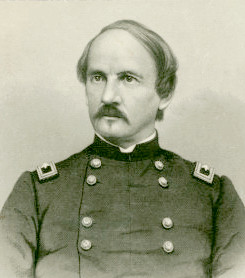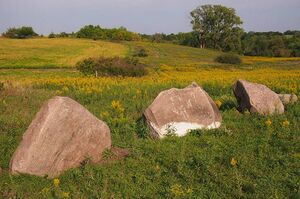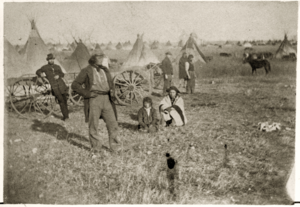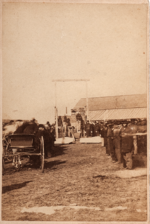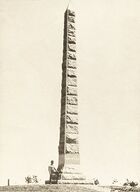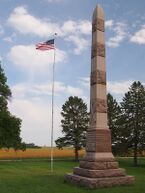حرب داكوتا 1862
| حرب داكوتا 1862 Dakota War of 1862 | |||||||
|---|---|---|---|---|---|---|---|
| جزء من حروب السو والحرب الأهلية الأمريكية | |||||||
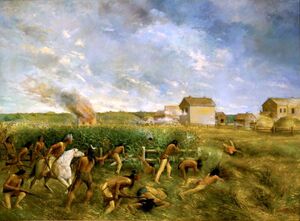 لوحة من سنة 1904 بعنوان "الهجوم على نيو أولم" بريشة أنطون گاگ | |||||||
| |||||||
| المتحاربون | |||||||
|
| داكوتا | ||||||
| القادة والزعماء | |||||||
|
|
الغراب الصغير Shakopee Red Middle Voice مانكاتو † النسر الكبير مجدوع الأنف | ||||||
| الضحايا والخسائر | |||||||
|
77 USV و 29 متطوع قتيل 450-800 civilians killed[1][2][3][4][5] | 150 dead, 38 executed[6]+2 executed November 11, 1865 | ||||||
حرب داكوتا عام 1862، والمعروفة أيضًا باسم انتفاضة السو، وانتفاضة داكوتا، واندلاع السو عام 1862، وصراع داكوتا أو حرب الولايات المتحدة ضد داكوتا عام 1862 أو حرب الغراب الصغير، نزاعاً مسلحاً بين الولايات المتحدة والعديد من الدول الأخرى. عصابات داكوتا الشرقية المعروفة أيضًا باسم "سو سانتي". بدأت في 18 أغسطس 1862، في وكالة سو السفلى على طول نهر مينسوتا في جنوب غرب ولاية مينسوتا.[7]
تعرضت مقاطعة داكوتا الشرقية لضغوط للتنازل عن مساحات كبيرة من الأراضي إلى الولايات المتحدة في سلسلة من المعاهدات الموقعة في أعوام 1837 و 1851 و 1858، مقابل المعاشات النقدية ومدفوعات الديون وغيرها من الأحكام.[8][9] تم تهجير جميع النطاقات الأربعة لشرق داكوتا، ولا سيما Mdewakanton، وانتقلت على مضض إلى محمية كانت بعرض عشرين ميلاً، عشرة على جانبي نهر مينسوتا.[9]
هناك، شجعهم الوكلاء الهنود الأمريكيون ليصبحوا مزارعين بدلاً من مواصلة تقاليدهم في الصيد.[9] في غضون ذلك، نما عدد المستوطنين في إقليم مينسوتا من 6077 في عام 1850 إلى 172.072 في عام 1860، بعد أن أصبحت ولاية.[10]
أدى فشل المحاصيل في عام 1861، وتلاه شتاء قاسٍ مع قلة الصيد بسبب استنفاد الطرائد البرية، إلى المجاعة والمعاناة الشديدة لكثير من مناطق داكوتا الشرقية.[11] في صيف عام 1862، وصلت التوترات بين داكوتا الشرقية والتجار والوكلاء الهنود إلى نقطة الانهيار، لأن الوكلاء الهنود تأخروا في دفع الأقساط للحكومة الأمريكية المستحقة لشرق داكوتا.[12]
رفض التجار تمديد الائتمان إلى رجال القبائل للحصول على الطعام، ويرجع ذلك جزئيًا إلى أن التجار اشتبهوا في أن المدفوعات قد لا تصل على الإطلاق بسبب الحرب الأهلية الأمريكية.[11][13]
في 17 أغسطس 1862، قتل أربعة شبان من السكان الأصليين خمسة مستوطنين بيض من أكتون، مينيسوتا.[14] في تلك الليلة، قرر فصيل بقيادة الرئيس ليتل كرو مهاجمة وكالة سيوكس السفلى في صباح اليوم التالي في محاولة لطرد جميع المستوطنين من وادي نهر مينيسوتا.[9] في الأسابيع التي تلت ذلك هاجم مقاتلو داكوتا وقتلوا مئات المستوطنين، مما تسبب في فرار الآلاف من المنطقة،[15] وأخذوا المئات من الرهائن من ذوي "الدم المختلط" والرهائن البيض ، وجميعهم تقريبا من النساء والأطفال.[16][17] أدت مطالب الحرب الأهلية إلى إبطاء استجابة الحكومة الأمريكية، ولكن في 23 سبتمبر 1862، قام الحاكم ألكسندر رامزي بتجميع جيش من المتطوعين من المشاة والمدفعية وميليشيا المواطنين بقيادة العقيد هنري هاستينگز سيبلي أخيرًا هزم ليتل كرو في معركة وود ليك.[9]
وبحلول نهاية الحرب قتل 358 مستوطنًا إضافة إلى 77 جنديًا و 29 من المليشيا المتطوعين.[18] العدد الإجمالي لضحايا داكوتا غير معروف. في 26 سبتمبر 1862، تم الإفراج عن 269 رهينة من ذوي "الدم المختلط" والرهائن البيض لقوات سيبلي في معسكر الإفراج.[19] استسلم ما يقرب من 2000 داكوتا أو تم احتجازهم،[20] بما في ذلك ما لا يقل عن 1658 من غير المقاتلين، بالإضافة إلى أولئك الذين عارضوا الحرب وساعدوا في تحرير الرهائن.[17][15] في هذه الأثناء، فر ليتل كرو ومجموعة من 150 إلى 250 من أتباعه إلى السهول الشمالية لإقليم داكوتا وكندا.[21][22]
في أقل من ستة أسابيع، حكمت اللجنة العسكرية ، المكونة من ضباط من فرقة المشاة المتطوعين في مينيسوتا، على 303 من رجال داكوتا بالإعدام. استعرض الرئيس ابراهام لنكن الإدانات ووافق على أحكام الإعدام لـ 39 من أصل 303.[9]
في 26 ديسمبر 1862، تم شنق 38 في مانكاتو، مينيسوتا مع إرجاء تنفيذ الحكم. كان هذا أكبر إعدام جماعي ليوم واحد في التاريخ الأمريكي. ألغى الكونگرس الأمريكي تحفظات داكوتا الشرقية وهو-تشانك (وينيباگو) في مينيسوتا وأعلن أن معاهدتيهما باطلة. في مايو 1863، تم نفي داكوتا الشرقية و Ho-chunk المسجونين في Fort Snelling من ولاية مينيسوتا. تم وضعهم على قوارب نهرية وإرسالهم إلى محمية في داكوتا الجنوبية الحالية. تم إجبار Ho-Chunk أيضًا في البداية على محمية كرو كريك، ولكن انتقلت لاحقًا إلى نبراسكا بالقرب من شعب أوماها لتشكيل Winnebago Reservation.[23][9]
في عامي 2012 و 2013، تم التنصل من دعوة الحاكم رامسي إلى داكوتا "للإبادة أو دفعها إلى الأبد خارج حدود الدولة".[24][25] في عام 2019، تم إصدار اعتذار لشعب داكوتا عن "150 عامًا من الصدمة التي تعرض لها السكان الأصليون على يد حكومة الولاية".[26] في عام 2021، نقل المجلس التشريعي لولاية مينيسوتا وجمعية مينيسوتا التاريخية (MNHS) ملكية 115 فدانًا من الأراضي إلى مجتمع سيوكس الهندي السفلي (LSIC)، بما في ذلك حوالي نصف الأراضي القريبة من وكالة سيوكس السفلى وجزء من موقع المعركة التاريخي. كانت جمعية مينيسوتا التاريخية MNHS و حمية سيوكس السفلى الهندية LSIC يديران الموقع بشكل مشترك.[27]
الخلفية
المعاهدات السابقة
التعديات على أموال داكوتا
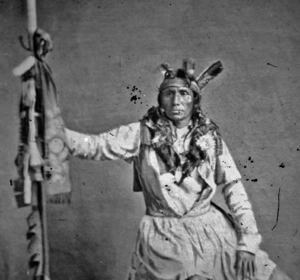
المفاوضات
الحرب
حادثة أكتون وما بعدها

هجوم على وكالة سو السفلى
الأسرى
هجمات داكوتا المبكرة
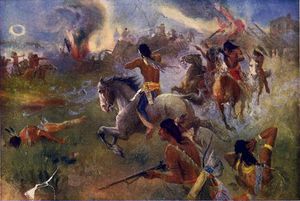
رد الدولة العسكري
إنهاء الحصار في فورت ريدلي
الدفاع على طول "الحدود" الجنوبية والجنوبية الغربية
لواء الحدود الشمالية لولاية أيوا
لقاءات في أوائل سبتمبر
معركة بيرش كولي
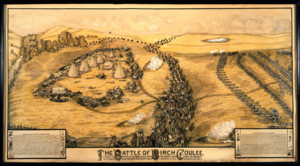
الهجمات في شمال مينسوتا وإقليم داكوتا
عزيزات الجيش
Battle of Wood Lake
"استسلام" في معسكر الإصدار
هروب وموت الغراب الصغير
ما بعد الكارثة
المحاكمات
الإعدامات

العواقب الطبية
السجن
الحبس في جزيرة پايك
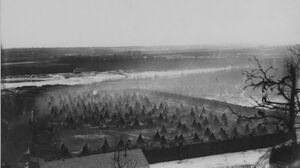
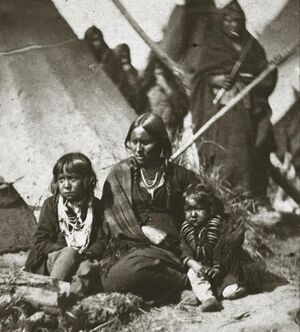
Firsthand accounts
روايات المستوطنين
الافتتاحيات في الصحف
استمرار الصراع
المنح
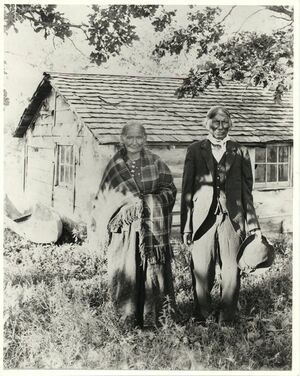
مينسوتا بعد الحرب
رفض خطاب رامسي واعتذاره لشعب داكوتا
عودة الأرض
الآثار والنصب التذكارية
الأحداث التذكارية
في وسائل الإعلام الشعبية
انظر أيضا
- Fort Ridgely State Park
- Monson Lake State Park
- Upper Sioux Agency State Park
- We-Chank-Wash-ta-don-pee
- List of Indian massacres
- الحروب الأمريكية الهندية
المصادر
- ^ Wingerd, p. 400 n 4.
- ^ Satterlee, Marion (1923). Outbreak and massacre by the Dakota Indians in Minnesota in 1862 : Marion P. Satterlee's minute account of the outbreak, with exact locations, names of all victims, prisoners at Camp Release, refugees at Fort Ridgely, etc. : complete list of Indians killed in battle and those hanged, and those pardoned at Rock Island, Iowa : interesting items and anecdotes. Minneapolis, MN: M.P. Satterlee. p. 125. ISBN 978-0-7884-1896-9. OCLC 48682232.
- ^ Kunnen-Jones, Marianne (August 21, 2002). "Anniversary Volume Gives New Voice To Pioneer Accounts of Sioux Uprising". University of Cincinnati. Archived from the original on June 19, 2008. Retrieved June 6, 2007.
- ^ University of Cincinnati News: Tolzmann Edits Pioneer Accounts of Sioux Archived يونيو 19, 2008 at the Wayback Machine
- ^ Kenneth Carley. The Dakota War of 1862.
- ^ Clodfelter, Micheal D. (2006). The Dakota War: The United States Army Versus the Sioux, 1862-1865. McFarland Publishing. p. 67. ISBN 978-0-7864-2726-0.
- ^ "During the War". The US–Dakota War of 1862. August 22, 2012. Archived from the original on November 3, 2012. Retrieved 2021-07-31.
- ^ Clemmons, Linda (2005). "'We Will Talk of Nothing Else': Dakota Interpretations of the Treaty of 1837". Great Plains Quarterly. 186 – via Digital Commons – University of Nebrasksa - Lincoln.
- ^ أ ب ت ث ج ح خ خطأ استشهاد: وسم
<ref>غير صحيح؛ لا نص تم توفيره للمراجع المسماة:6 - ^ "Minnesota Territory, 1857". The US–Dakota War of 1862. September 2, 2012. Retrieved 2022-02-21.
- ^ أ ب Mary Lethert Wingerd, North Country: The Making of Minnesota (2010) p. 302.
- ^ خطأ استشهاد: وسم
<ref>غير صحيح؛ لا نص تم توفيره للمراجع المسماة: 27 - ^ خطأ استشهاد: وسم
<ref>غير صحيح؛ لا نص تم توفيره للمراجع المسماة:14 - ^ "The Acton Incident". The US–Dakota War of 1862. February 27, 2013. Archived from the original on February 22, 2015. Retrieved 2021-07-17.
- ^ أ ب Anderson, Gary Clayton (2019). Massacre in Minnesota: The Dakota War of 1862, the Most Violent Ethnic Conflict in American History. Norman: University of Oklahoma Press. ISBN 978-0-8061-6434-2
- ^ "During the War". The US–Dakota War of 1862. August 22, 2012. Archived from the original on November 3, 2012. Retrieved 2021-07-30.
- ^ أ ب خطأ استشهاد: وسم
<ref>غير صحيح؛ لا نص تم توفيره للمراجع المسماة:13 - ^ Wingerd, North Country (2010) p. 400 n 4.
- ^ خطأ استشهاد: وسم
<ref>غير صحيح؛ لا نص تم توفيره للمراجع المسماة:20 - ^ خطأ استشهاد: وسم
<ref>غير صحيح؛ لا نص تم توفيره للمراجع المسماة:21 - ^ Anderson, Gary Clayton; Woolworth, Alan R., eds. (1988). Through Dakota Eyes: Narrative Accounts of the Minnesota Indian War of 1862. St. Paul: Minnesota Historical Society Press. pp. 2, 4, 120, 141, 268. ISBN 978-0-87351-216-9.
- ^ خطأ استشهاد: وسم
<ref>غير صحيح؛ لا نص تم توفيره للمراجع المسماة:22 - ^ "Ho-Chunk and Blue Earth, 1855–1863". MNopedia. September 30, 2021. Retrieved September 30, 2021.
- ^ Nelson, Emma (August 16, 2012). "Dayton repudiates Ramsey's call to exterminate Dakota". MN Daily. Retrieved August 26, 2022.
- ^ "Dayton repudiates Ramsey's call to exterminate Dakota". Star Tribune. May 2, 2013. Retrieved August 26, 2022.
- ^ "Dakota Governor Walz makes historic apology for 1862 mass hanging in Mankato". Indian Country Today. January 2, 2020. Retrieved August 26, 2022.
- ^ خطأ استشهاد: وسم
<ref>غير صحيح؛ لا نص تم توفيره للمراجع المسماةtransfer
قراءات إضافية
- Anderson, Gary Clayton. Massacre in Minnesota: The Dakota War of 1862, the Most Violent Ethnic Conflict in American History (Norman: University of Oklahoma Press, 2019) ISBN 9780806164342
- Beck, Paul N., Soldier Settler and Sioux: Fort Ridgely and the Minnesota River Valley 1853–1867. Sioux Falls, SD: Pine Hill Press, 2000.
- Beck, Paul N. Columns of Vengeance: Soldiers, Sioux, and the Punitive Expeditions, 1863-1864. Norman, OK: University of Oklahoma Press, 2013.
- Berg, Scott W., 38 Nooses: Lincoln, Little Crow, and the Beginning of the Frontier's End. New York: Pantheon, 2012. ISBN 0-307377-24-5
- Carley, Kenneth. The Sioux uprising of 1862 (2nd ed. Minnesota Historical Society, 1976), 102pp well illustrated.
- Chomsky, Carol. "The United States-Dakota War Trials: A Study in Military Injustice". 43 Stanford Law Review 13 (1990).
- Clemmons, Linda M. Dakota in Exile: The Untold Stories of Captives in the Aftermath of the US–Dakota War. Iowa City, IA: University of Iowa Press, 2019.
- Collins, Loren Warren. The Story of a Minnesotan, (private printing) (1912, 1913?). OCLC 7880929
- Cox, Hank. Lincoln And The Sioux Uprising of 1862, Cumberland House Publishing (2005). ISBN 1-58182-457-2
- Folwell, William W.; Fridley, Russell W. A History of Minnesota, Vol. 2, pp. 102–302, St Paul, MN: Minnesota Historical Society Press, 1961. ISBN 978-0-87351-001-1
- Haymond, John A. The Infamous Dakota War Trials of 1862: Revenge, Military Law and the Judgment of History. Jefferson, NC: McFarland, 2016. ISBN 1-476665-10-9
- Jackson, Helen Hunt. A Century of Dishonor: A Sketch of the United States Government's Dealings with some of the Indian Tribes (1887), Chapter V.: The Sioux, pp. 136–185.
- Johnson, Roy P. The Siege at Fort Abercrombie, State Historical Society of North Dakota (1957). OCLC 1971587
- Lass, William. "Little Crow and the Dakota War" Annals of Iowa (2007) 66#2 pp 196–197.
- Linder, Douglas The Dakota Conflict Trials of 1862 (1999).
- Nichols Roger L. Warrior Nations: The United States and Indian Peoples. Norman, OK: University of Oklahoma Press, 2013.
- Schultz, Duane. Over The Earth I Come: The Great Sioux Uprising Of 1862. New York: St. Martin's Griffin (1993). ISBN 9780312093600
- Wingerd, Mary Lethert. North Country: The making of Minnesota (U of Minnesota Press, 2010).
- Yenne, Bill. Indian Wars: The Campaign for the American West Yardley, PA: Westholme Publishing, 2005. ISBN 1-59416-016-3
المصادر الأولية
- Anderson, Gary and Alan Woolworth, editors. Through Dakota Eyes: Narrative Accounts of the Minnesota Indian War of 1862. St Paul, MN: Minnesota Historical Society Press, 1988. ISBN 0-87351-216-2
- Big Eagle, Jerome and Return Ira Holcombe. "A Sioux Story of the War: Chief Big Eagle's Story of the Sioux Outbreak of 1862." Originally published in Saint Paul Pioneer Press and bound by Minnesota Historical Society (1894).
- Blegen, Theodore C. and Guri Endreson. "Guri Endreson, Frontier Heroine." Minnesota History 10:4 (December 1929), pp. 425–430. JSTOR 20160816
- Connolly, Alonzo Putnam. A Thrilling Narrative of the Minnesota Massacre and the Sioux War of 1862–63. Chicago: A. P. Connolly, 1896.
- Dahlin, Curtis. The Dakota Uprising, A Pictorial History. (Robert Hale, 1984, London) heavily illustrated with 275 photographs
- Fearing, Jerry, ed. The Picture History of the Minnesota Sioux Uprising. St. Paul Pioneer Press, 1962.
- Nix, Jacob. The Sioux Uprising in Minnesota, 1862: Jacob Nix's Eyewitness History, Max Kade German-American Center (1994). ISBN 1-880788-02-0
- Renville. Gabriel and Samuel J. Brown. A Sioux Narrative of the Outbreak in 1862 and of Sibley's Expedition in 1863. St. Paul: Minnesota Historical Society, 1905.
- Renville, Mary Butler, ed. A Thrilling Narrative of Indian Captivity: Dispatches from the Dakota War. Lincoln: University of Nebraska Press, 2012. online review
- Schwandt-Schmidt, Mary. "The Story of Mary Schwandt: Her Captivity During the Sioux Outbreak – 1862." Minnesota Historical Collections (July 26, 1894).
- Snana (Maggie Brass) and Return Ira Holcombe. "Narration of a Friendly Sioux." Minnesota Historical Collections, Vol. 9 (1901).
- Tolzmann, Don Heinrich, ed. German Pioneer Accounts of the Great Sioux Uprising of 1862. Milford, OH: Little Miami Publishing, 2002. ISBN 978-0-9713657-6-6
التأريخ
- Carlson, Kelsey, and Gareth E. John. "Landscapes of triumphalism, reconciliation, and reclamation: memorializing the aftermath of the Dakota-U.S. War of 1862." Journal of Cultural Geography 32.3 (2015): 270-303. https://doi.org/10.1080/08873631.2015.1067951
- John, G. E., and K. M. Carlson. "‘Making Change’ in the memorial landscape to the Dakota–U.S. War of 1862: remembrance, healing and justice through affective participation in the Dakota Commemorative March (DCM)." Social & Cultural Geography 17.8 (2016): 987-1016.
- Lass, William E. "Histories of the U.S.–Dakota War of 1862." Minnesota History (2012) 63#2 pp 44–57 online
- Lybeck, Rick. "Fear and Reconciliation: The US-Dakota War in White Public Pedagogy." (PhD dissertation U of Minnesota 2015). online
- Lybeck, Rick. "The rise and fall of the U.S.-Dakota War hanging monument: Mediating old-settler identity through two expansive cycles of social change." Mind, Culture, and Activity (2015) 22#11, pp. 37–57. https://doi.org/10.1080/10749039.2014.984311
روابط خارجية
- "Minnesota Historical Society History Topics: US-Dakota War of 1862". Archived from the original on December 19, 2013.
- Minnesota Historical Society: US-Dakota War of 1862
- Minnesota Historical Society: Historic Fort Snelling: The US-Dakota War of 1862
- Dakota Conflict Documentary produced by Twin Cities Public Television (also here)
- Dakota Exile Documentary produced by Twin Cities Public Television (also here)
- Short description is different from Wikidata
- Articles with hatnote templates targeting a nonexistent page
- حرب داكوتا 1862
- 1862 في الولايات المتحدة
- 1862 في مينسوتا
- الإبادة الجماعية في شعوب أصلية في الأمريكتين
- تاريخ الأمريكيين الأصليين في مينسوتا
- تاريخ الولايات المتحدة (1849–1865)
- حروب الولايات المتحدة
- مانكاتو (مينسوتا)
- مقاطعة براون (مينسوتا)
- مقاطعة بلو إرث (مينسوتا)
- مقاطعة لي سويور (مينسوتا)
- مقاطعة نيكوليت (مينسوتا)
- نزاعات في 1862
- نهر مينسوتا
- نيو أولم
- الإبادة الجماعية في شعوب أصلية في أمريكا الشمالية
